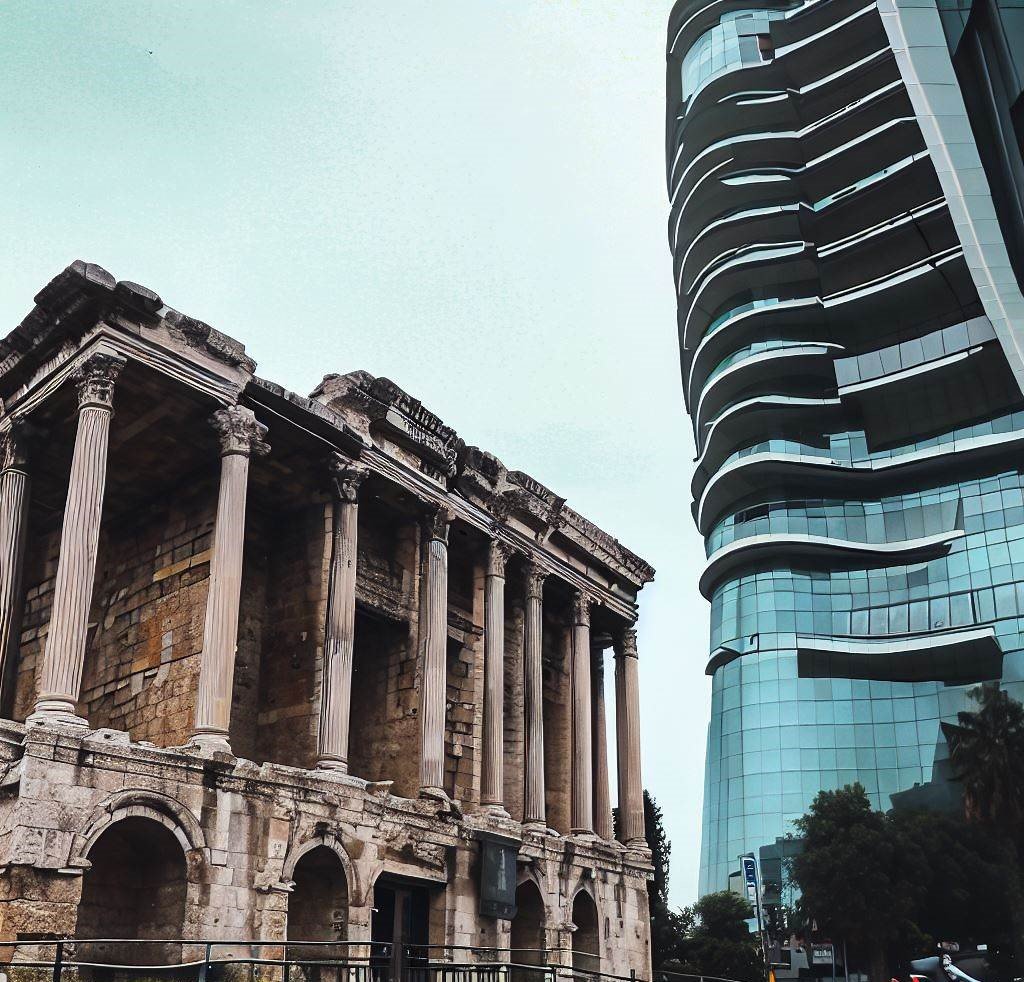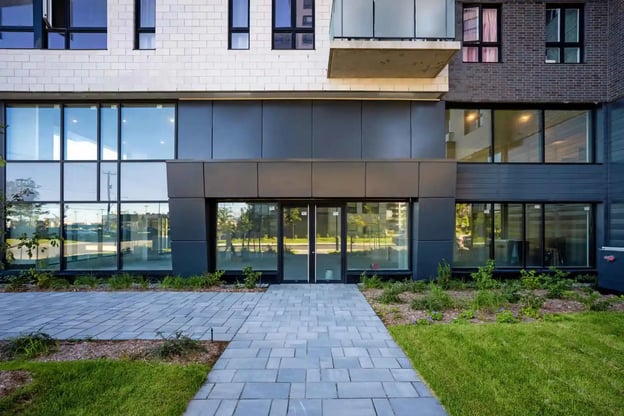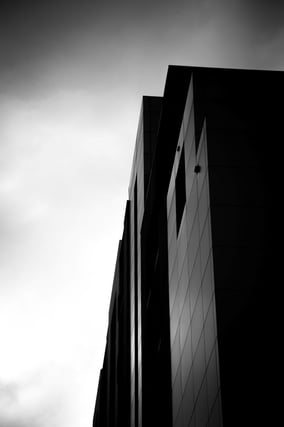As we stand in awe of the majestic modern skyscrapers and architectural marvels, it is all too easy to overlook the tremendous journey that has led to their breathtaking facades. This journey has been a remarkable voyage through time, filled with innovation, bold experimentation, and unrivaled design expertise. From the humble origins of stucco and brick to the cutting-edge era of aluminum panels, the evolution of cladding materials weaves a captivating tale of human ingenuity and an unwavering pursuit of aesthetic perfection.
Stucco and Brick: The Humble Beginnings
Journey with me back to ancient times, to the bustling streets of ancient Rome, where buildings were adorned with stucco and brick. These earliest forms of cladding served a dual purpose: protection against the elements and an opportunity to showcase artistic flair. Stucco, a mixture of cement, sand, and lime, was skillfully applied to the building's surface, offering a smooth and decorative finish that spoke of craftsmanship and pride. It was not just a practical solution to protect the underlying structure from rain, wind, and temperature fluctuations, but also a way to beautify the cityscape and create a sense of grandeur.
In ancient Rome, stucco was not merely a utilitarian material; it was a means of artistic expression. Skilled craftsmen would meticulously sculpt intricate patterns and designs onto the stucco surface, turning ordinary buildings into works of art. These decorative elements, known as "stucco relief," could depict scenes from mythology, historical events, or simply ornate patterns that added a touch of elegance to the architecture. The use of stucco allowed the Romans to showcase their creativity and establish their aesthetic sensibilities.
Brick, on the other hand, offered a different kind of appeal. Its earthy charm and durable qualities created a rugged texture that seemed to whisper tales of a bygone era. Each brick was carefully laid by skilled masons, creating a structure that not only withstood the test of time but also had a distinct character. The use of brick as a cladding material was not just practical but also symbolic. It represented the strength and resilience of the Roman Empire, standing as a testament to its architectural prowess.
As the Roman Empire expanded, so did the use of stucco and brick as cladding materials. The grandeur of Rome's architecture spread throughout the empire, with buildings in cities like Pompeii and Ostia showcasing the same level of craftsmanship and attention to detail. Stucco and brick became a defining feature of ancient Roman architecture, influencing the styles and techniques used by future generations.
The legacy of stucco and brick can still be seen in modern architecture. While the materials themselves have evolved, their impact on the field of cladding is undeniable. The use of stucco and brick in ancient Rome laid the foundation for the exploration of new cladding materials and techniques, ultimately leading to the development of innovative solutions like aluminum panels. As we marvel at the skyscrapers and architectural wonders of today, let us not forget the humble beginnings of stucco and brick, for they have left an indelible mark on the world of cladding.
The Renaissance of Cladding: Enter Panels
As centuries swept by, the world of cladding materials underwent a Renaissance of its own. The Industrial Revolution, with its groundbreaking advancements and technological innovations, ignited an era of transformation and progress in the field of cladding. The traditional methods of cladding, such as stucco and brick, began to give way to new and exciting possibilities.
With the birth of modern construction materials like steel and glass, the stage was set for the rise of panels – cladding components that could be pre-fabricated off-site and easily integrated into a structure. This marked a significant shift in the way buildings were constructed and the opportunities available to architects and designers.
Panels revolutionized the construction industry by streamlining the building process and reducing construction time. The ability to prefabricate panels off-site allowed for greater efficiency, precision, and control in the construction process. Architects and builders could now work with standardized cladding components that could be easily assembled on-site, eliminating the need for traditional, time-consuming methods.
Diversity in Panels: From Concrete to Glass
The mid-20th century saw panels take center stage in the architectural realm. A mesmerizing parade of diverse cladding materials graced the skylines. Concrete panels embraced the sleek, minimalist aesthetic, while glass panels shattered the conventional notion of boundaries by allowing light to infiltrate spaces with ethereal grace. As technology advanced, composite panels emerged, offering the strength of metal interwoven with the aesthetics of other materials. Architects reveled in a smorgasbord of choices to manifest their visions.
Furthermore, panels presented architects with a broader canvas for creative expression. The introduction of materials like steel and glass brought about a new era of architectural design, characterized by sleek lines, transparency, and a sense of lightness. Steel panels, with their strength and durability, offered architects the opportunity to create structures with bold and daring designs that were previously unimaginable. Glass panels shattered the conventional notion of boundaries by allowing light to infiltrate spaces with ethereal grace, creating a seamless connection between the built environment and the natural world.
The diversity of cladding materials expanded during this period, offering architects a range of options to manifest their visions. Concrete panels embraced the sleek, minimalist aesthetic, while composite panels combined the strength of metal with the aesthetics of other materials. The possibilities seemed endless, and architects reveled in the newfound freedom to explore and experiment with different materials and styles.
Aluminum Panels: The Ultimate Fusion of Form and Function
And then, as if summoned from a realm of innovation, aluminum panels emerged as the pièce de résistance of cladding materials. Lightweight yet resilient, aluminum panels represented the harmonious synthesis of years of progress and imagination. These panels provided architects and designers with an unparalleled degree of creative freedom. They discovered that aluminum's malleability allowed their visions to transcend the bounds of imagination.
The allure of aluminum panels resides not solely in their aesthetics, but also in their versatility. Be it sweeping curves that echo the natural world's fluidity or sharp angles that exude modernism's vigor, aluminum panels conform to the architect's whims. However, their allure transcends appearances. These panels embody environmental responsibility through their recyclability and energy efficiency, aligning perfectly with the values of our eco-conscious era.
A Glimpse into Tomorrow: The Promise of Aluminum Panels
Looking to the future, the trajectory of innovation in cladding materials seems boundless. As technology advances, we can envision self-cleaning panels that repel dirt with ease, or panels that harness solar energy to power buildings sustainably. The path ahead is one where aesthetics, functionality, and environmental stewardship seamlessly intertwine.
Maibec: A Part of Our Aluminum Panel Journey
In the unfolding story of cladding evolution, Maibec emerges as a vital chapter in the narrative of aluminum panels. At Maibec, we are not just creating facades; we are crafting stories that reflect our passion for design excellence and sustainability. Our journey mirrors the evolution of cladding materials, and aluminum panels have become the canvas upon which we paint our vision for the future. Much like aluminum panels represent the pinnacle of cladding innovation, Maibec epitomizes the culmination of design ingenuity and unwavering commitment to a better world.
From our very inception, we understood the inherent power of aluminum panels to transform architectural dreams into tangible realities. The synergy between our craftsmanship and the versatility of aluminum empowers us to translate the architect's vision into structures that inspire awe. Whether it's the sinuous lines of a waterfront project or the precision angles of an urban masterpiece, we stand alongside architects as co-creators, shaping the skyline and embodying the spirit of innovation.
However, our commitment extends beyond aesthetics; it encompasses sustainability – a principle that resonates with aluminum panels themselves. We embrace the ethos of aluminum panels, creating designs that are environmentally conscious without compromising on beauty or functionality. Our panels echo the fusion of forward-thinking technology and responsible construction practices, contributing to a greener, more sustainable future.
In conclusion, the journey through the evolution of cladding materials is a testament to human creativity, resilience, and the relentless pursuit of progress. From the foundational stucco and brick to the boundless possibilities of aluminum panels, our architectural feats narrate a story of ceaseless innovation. Our work epitomizes the fusion of form and function, embodying a shared vision where beauty, sustainability, and cutting-edge craftsmanship harmoniously converge. So, the next time you gaze upon a marvel of contemporary architecture, remember that it stands as a monument to our journey – a journey that began with humble stucco and brick and flourished into the aluminum-clad wonders that grace our world today, driven, in part, by the collaborative spirit of Maibec.




